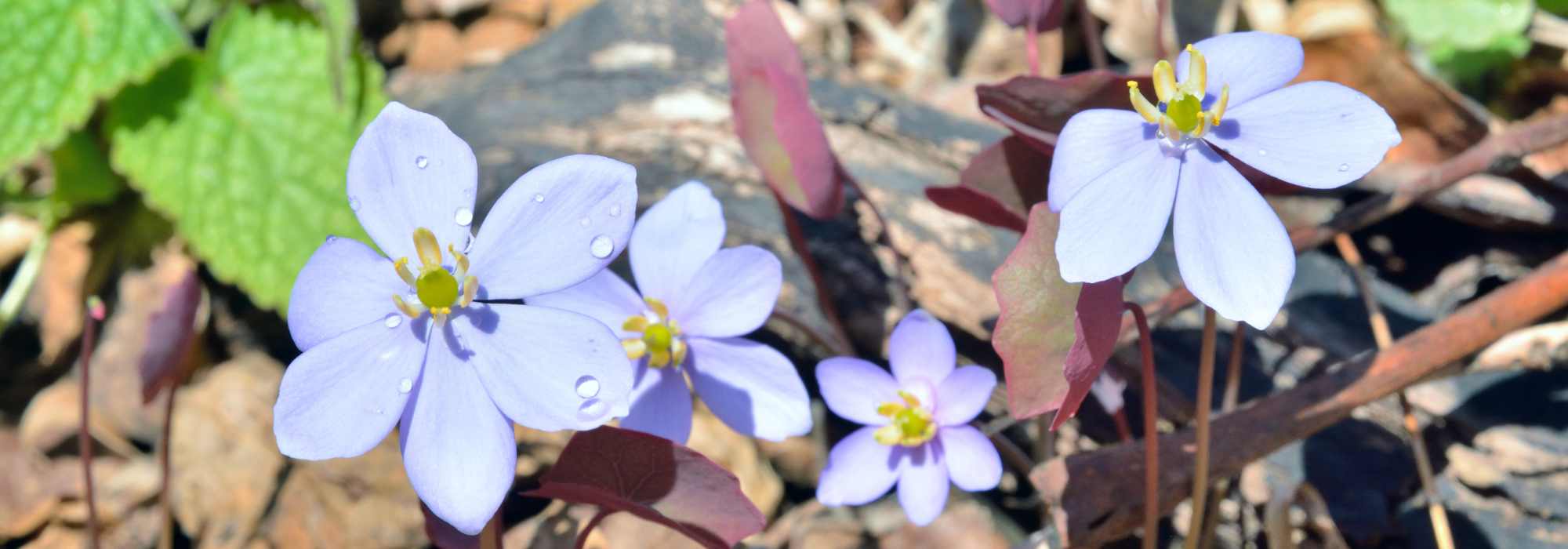
Jeffersonia: Planting and Cultivation
Contents
The Jeffersonia in a few words
- Jeffersonia is a small perennial plant, perfect for shady spots
- It is an elegant ground cover with pretty deciduous foliage shaped like butterfly wings
- Its early spring flowering emerges from the soil at the first signs of fine weather, before the foliage appears
- Hardy and easy to grow, it requires no maintenance
- It brings freshness and brightness to the base of deciduous trees and bushes or in partially shaded rockeries with cool soil
The word from our expert
Jeffersonia is a small, hardy perennial suited to cool woodland settings and shady areas. It is highly prized for its very pretty deciduous, lobed, fresh green leaf and delightful spring flowering in small white bells for Jeffersonia diphylla or mauve for Jeffersonia dubia. In the garden, it forms tapetums of leaves that gradually spread over time, thanks to their rootstocks, at the base of hedges or trees and bushes, along pathways, in rockeries, or shaded borders. The dense and lush leaf of Jeffersonia makes it an excellent ground cover. This creeping perennial thrives in partial shade, in well-drained soil rich in humus, retaining some coolness in summer.
Easy to grow, it flourishes in the garden for years, requiring almost no maintenance, and helps avoid weeding in cool or hard-to-plant corners.
Discover this charming woodland perennial rootstock plant today!
Description and Botany
Botanical data
- Latin name Jeffersonia
- Family Berberidaceae
- Common name Jeffersonia
- Flowering April
- Height 0.10- 0.15 m
- Sun exposure Sun, partial shade
- Soil type Rich, fresh, well-drained
- Hardiness -15°C
Jeffersonia is a perennial plant from the Berberidaceae family, like Epimedium or Barrenwort. It is native to temperate regions of America, from the eastern United States, Minnesota to southern Tennessee, as well as Korea to China, and as far as eastern Russia. It grows wild in deciduous forests, thickets, often in ravines or on shaded, moist rocky slopes, on slightly alkaline soils, up to 1,100 metres in altitude. The Jeffersonia genus includes only two species: Jeffersonia diphylla, the native species of North American woodlands, and Jeffersonia dubia, the small Asian variety. The plant is named after Thomas Jefferson, the first President of the United States.
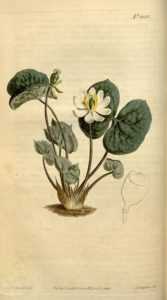
Jeffersonia diphylla, botanical illustration
From a short, creeping rootstock, Jeffersonia forms small, long-lasting clumps over time, reaching 10 to 15 cm in height and at least 25 cm in width. This creeping perennial slowly creates a carpet of leaves that will colonise cool spots, woodland areas, the base of trees and bushes, or shaded flower beds. It spreads slowly as ground cover, never becoming invasive.
Flowering is early, starting at the beginning of spring in April. The solitary flowers emerge from the soil before the leaves. The blooms take the form of star-shaped cups, 2 to 2.5 cm in diameter, composed of 6 to 8 broad petals. These delicate bells are lavender-coloured or pure white, surrounding a yellow centre. Their simplicity resembles that of botanical tulips.
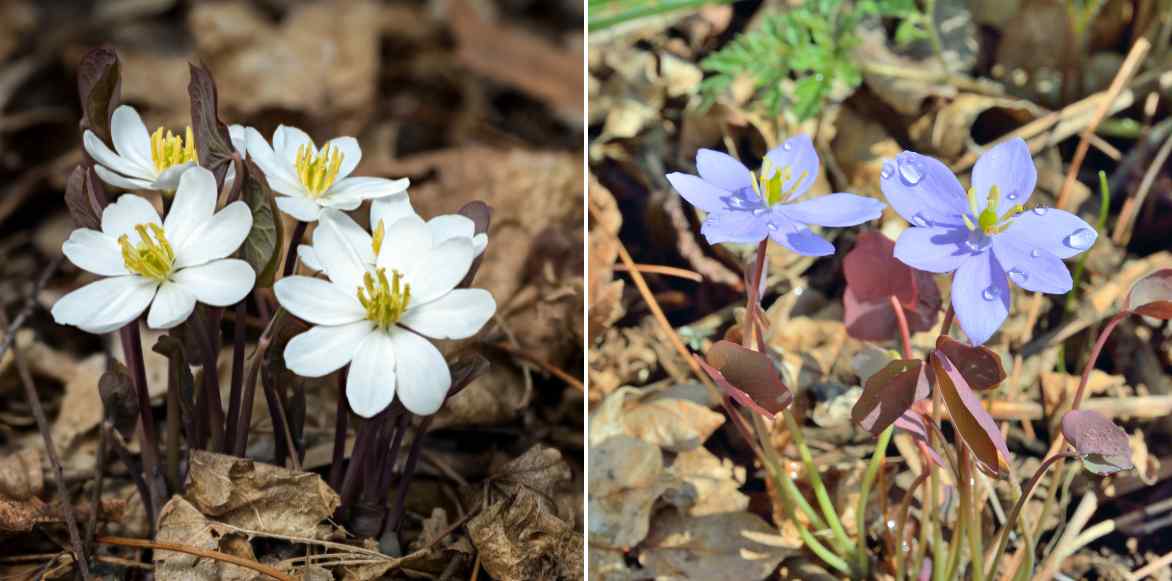
Jeffersonia diphylla and Jeffersonia dubia
In spring, the stems develop a delicate deciduous foliage, highly ornamental and easily recognisable. The leaves unfold into rounded, fleshy laminae, deeply notched at their base into two twin leaflets, semi-oval in shape, arranged symmetrically around the petiole and toothed at the edges. Borne on long, upright petioles, they measure 6-8 cm in diameter, each resembling a butterfly wing. Young shoots emerge in bronze tones, maturing into a beautiful apple-green to bluish-green edged with reddish-brown. This lobed foliage, veined and slightly textured, remains lush after flowering. The flowers then transform into curious, leathery fruits, pear-shaped capsules containing red seeds.
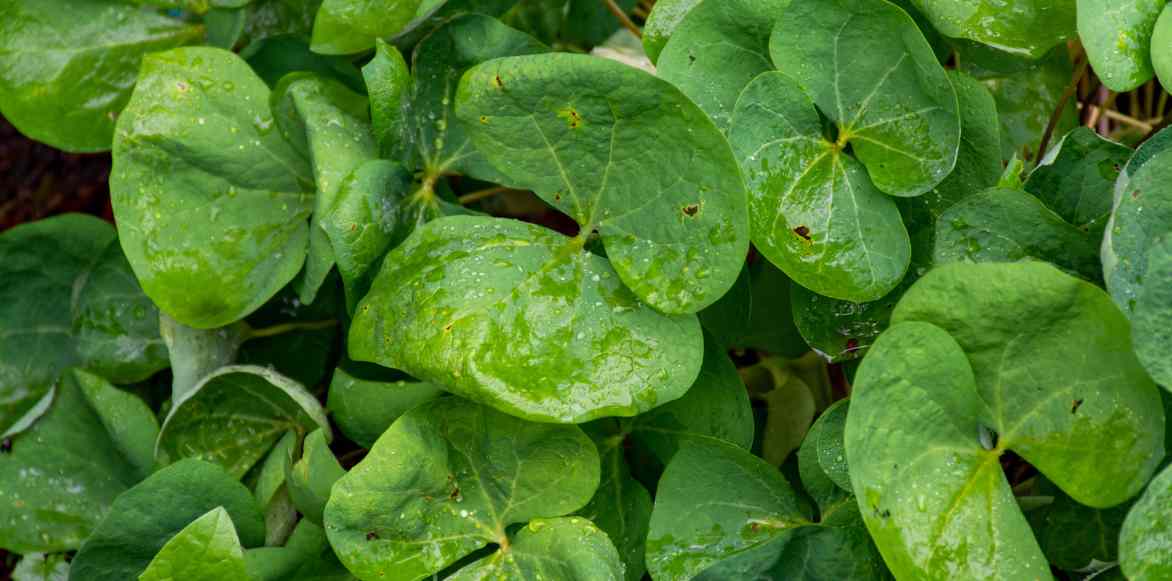
The highly original foliage of Jeffersonia diphylla
Main species
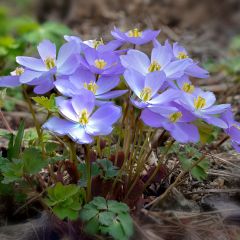
Jeffersonia dubia
- Mois de floraison May
- Hauteur à maturité 12 cm
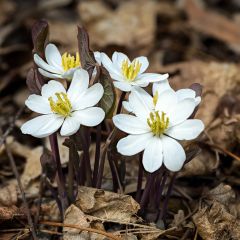
Jeffersonia diphylla
- Mois de floraison May
- Hauteur à maturité 10 cm
Planting
Where to Plant It?
Hardy to at least -15°C, the Jeffersonia can be grown in most regions, except perhaps in Mediterranean climates, which are too dry in summer. Let’s not forget that it is a woodland plant that thrives in humus-rich soils, acidic to calcareous, remaining moist. It tolerates naturally calcareous soils well. Avoid planting it in direct sunlight. The Jeffersonia prefers a partially shaded position, in non-scorching sun and light shade. Too much shade can hinder its flowering. Once well established, under the cover of deciduous trees or bushes that will protect it from summer heat, it will form beautiful leafy tapetums of great freshness. It is an excellent ground cover, ideal for dressing a shaded and cool rockery, a leafy woodland, or a shrubby border. You can also plant it in a shaded area that is difficult to cultivate and maintain.
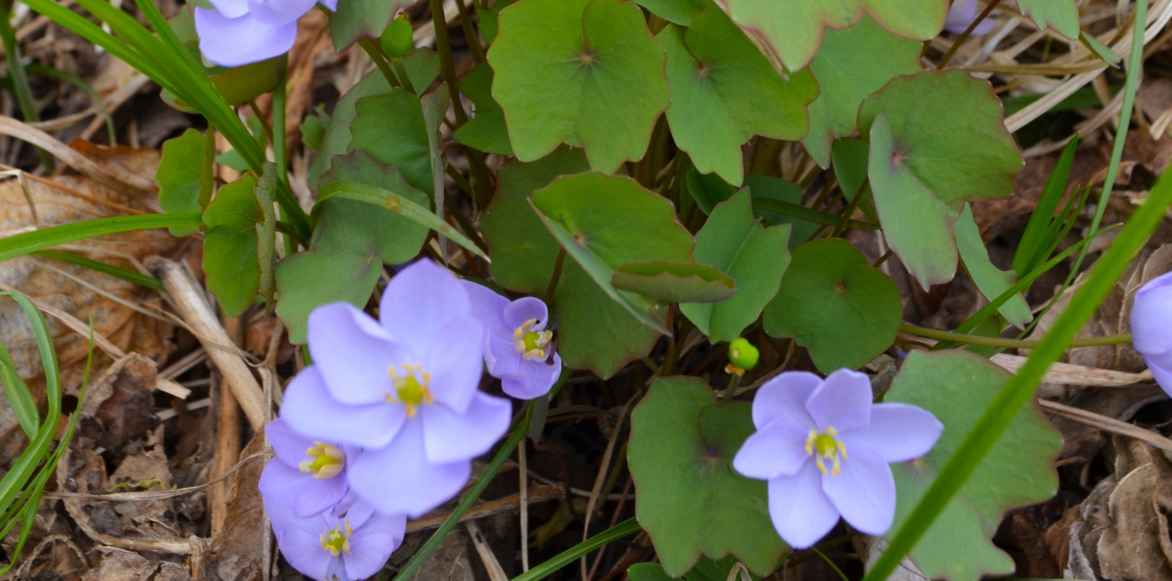
Jeffersonia dubia, the Asian species
When to Plant Jeffersonia?
Jeffersonia is best planted in spring, from March to April or May, after the frosts, or in autumn from September to November.
How to Plant Jeffersonia?
Plan for 5 to 6 young plants per m² to create a perennial and well-covering foliage tapetum, while maintaining a distance of 30 cm between each young plant. The soil should be sufficiently drained. If it is clayey, add gravel or clay pebbles to improve drainage.
- Loosen the soil well
- Dig a hole 2 to 3 times the size of the root ball
- In heavy soil, spread drainage materials at the bottom of the hole
- Plant in the centre of the hole
- Fill the hole with a mixture of garden soil, sand, and good-quality compost
- Lightly firm the soil with your foot
- Mulch the base with a mulch to retain moisture
- Water generously and then regularly to encourage establishment
Maintenance of Jeffersonia
The Jeffersonia requires almost no maintenance. Its lush foliage smothers weeds, sparing you the chore of weeding. This perennial plant spreads slowly over the soil, provided it remains well-drained and sufficiently moist in summer. It does not tolerate overly dry soils well. Avoid planting it in soils that dry out easily. Even in summer, during its dormant period, it is best to water it to prevent the foliage from drying out completely. Water regularly, once or twice a week, during the first summer after planting, and monitor water needs during prolonged heatwaves and droughts. In spring, apply a good layer of organic mulch (straw, dead leaves, etc.) to reduce evaporation in summer and protect its rhizomatous roots from harsh winter frosts.
At the end of winter, when the flower buds appear, remove the old foliage by cutting the clump back to ground level. Do this before early spring to avoid accidentally cutting the young flower stems as they form.
Each spring, you can add a little compost around the base with light raking to encourage growth, enrich the soil, and keep it slightly less dry.
It is rarely affected by diseases. However, in spring, protect its young shoots from snails and slugs. If necessary, use fern liquid manure to deter their attacks.
⇒ Discover the right techniques for planting a perennial correctly in our video!
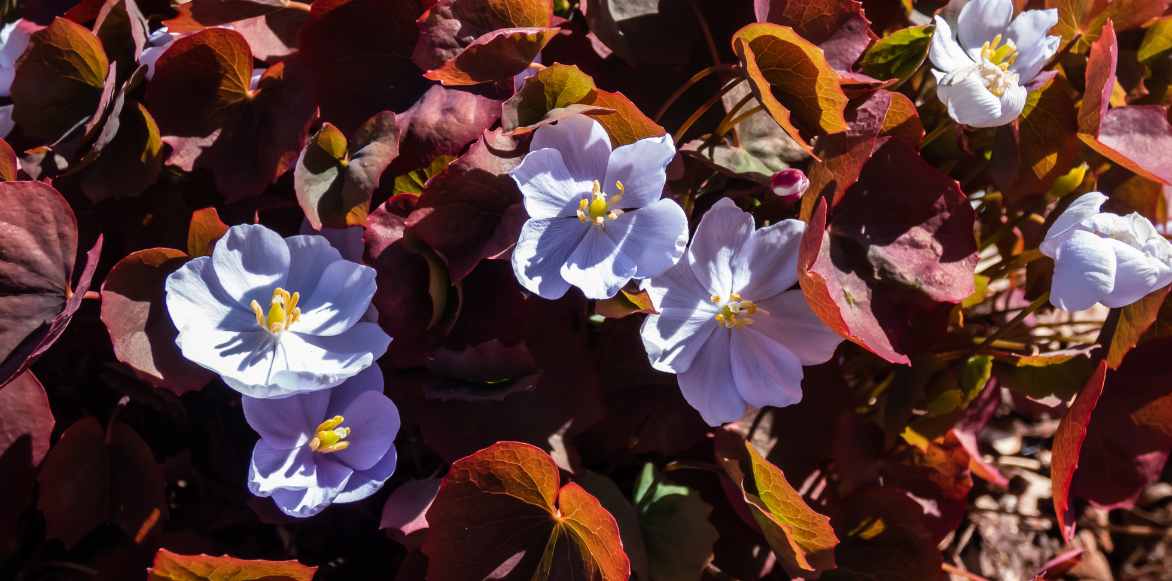
Jeffersonia dubia
Multiplication
To propagate Jeffersonia, we recommend dividing clumps, a simple technique to carry out in summer or early autumn. After 3-4 years, the plant may show signs of fatigue; divide the most substantial stumps to rejuvenate the plant and maintain a floriferous clump.
- Using a spade, dig around the clump
- Lift the root ball with a garden fork
- Divide the clump, taking rootstocks from the edges with a rosette of leaves
- Replant the rootstock fragments immediately in well-prepared soil
- Water generously
Association
With their elegant and ground-covering foliage and their very early spring flowers, the Jeffersonias (dubia and diphylla) are perfect for greening neglected spaces or shady corners in a natural or wild garden. Thriving in humus-rich and moist soils, they flourish in woodland areas where they pair well with Fairy Wings, Anemone nemorosa, hepatica, Hellebores, and ferns such as Dryopteris wallichiana, or with bluebells (Hyacinthoides non-scripta).
In a woodland garden, they complement spring-flowering perennials such as hardy geraniums, Cyclamen coum, or the delicate Bleeding Hearts, as well as trees and bushes, particularly those with spring blooms like Viburnums and ornamental Prunus, beneath which they form leafy carpets. It’s wise to surround them with spring bulbs, both early and late, to extend the enchanting effect of their flowering; Grape Hyacinths, daffodils, botanical tulips…
Their ability to cover shaded areas with their foliage for long months makes them indispensable in semi-shaded rockeries where the soil remains moist. You can surround them with miniature Hostas and Carex.
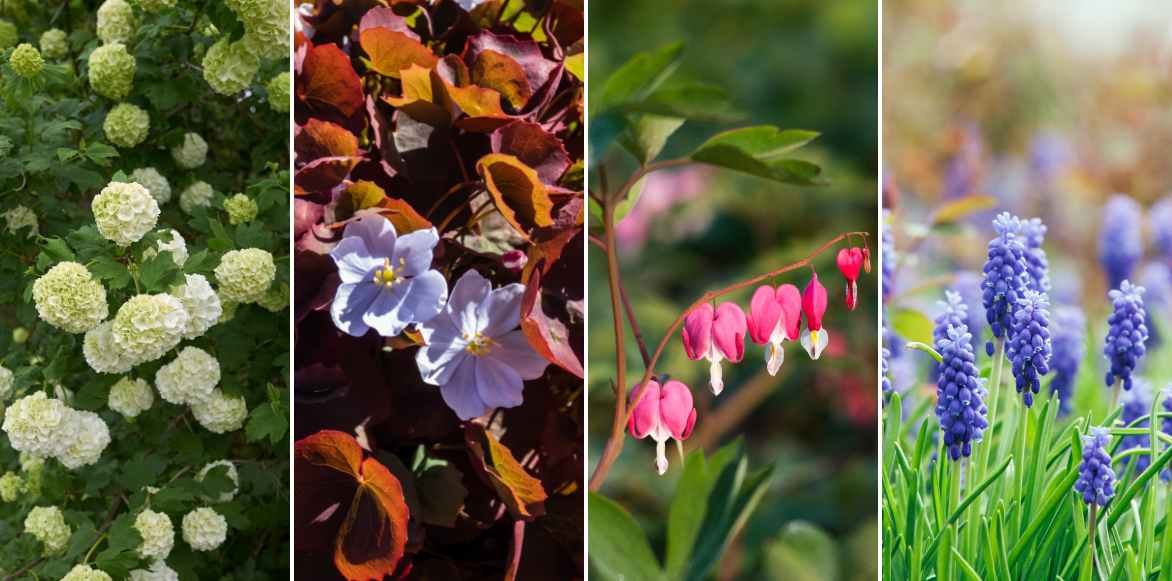
Viburnum opulus, Jeffersonia dubia, Dicentra spectabilis, and grape hyacinths
- Subscribe!
- Contents































Comments